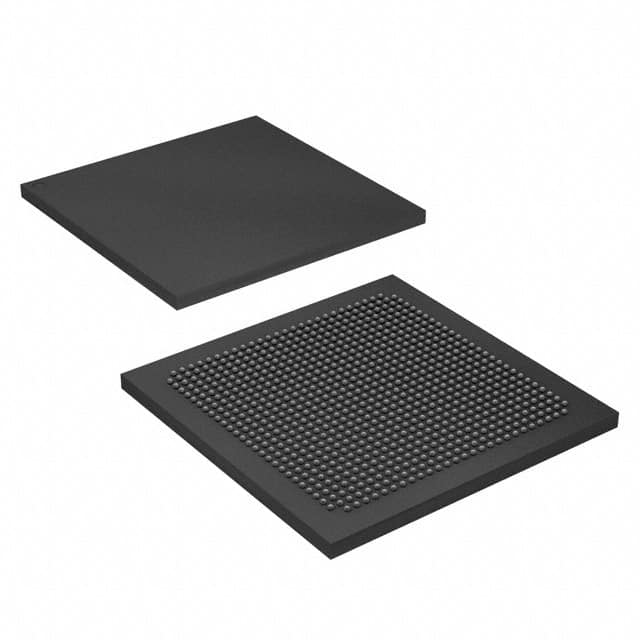Lihat spesifikasi untuk detail produk.

5SGSMD4E2H29C1N
Product Overview
Category
The 5SGSMD4E2H29C1N belongs to the category of Field Programmable Gate Arrays (FPGAs).
Use
FPGAs are integrated circuits that can be programmed and reprogrammed to perform various digital functions. The 5SGSMD4E2H29C1N is specifically designed for high-performance applications.
Characteristics
- High-speed processing capabilities
- Large number of configurable logic blocks
- Flexible and reprogrammable design
- Low power consumption
- High reliability and durability
Package
The 5SGSMD4E2H29C1N comes in a compact package, suitable for easy integration into electronic systems.
Essence
The essence of the 5SGSMD4E2H29C1N lies in its ability to provide customizable digital logic functions, allowing designers to implement complex algorithms and systems on a single chip.
Packaging/Quantity
The 5SGSMD4E2H29C1N is typically packaged individually and is available in various quantities depending on the manufacturer's specifications.
Specifications
- Logic Elements: 220,000
- Embedded Memory: 9,840 Kbits
- DSP Blocks: 1,288
- Maximum User I/Os: 622
- Operating Voltage: 1.2V
- Operating Temperature: -40°C to 100°C
- Package Type: Ball Grid Array (BGA)
- Package Size: 29mm x 29mm
Detailed Pin Configuration
The 5SGSMD4E2H29C1N has a complex pin configuration with multiple pins dedicated to different functions. Please refer to the datasheet provided by the manufacturer for detailed pin configuration information.
Functional Features
- High-speed data processing capabilities
- Configurable logic blocks for custom functionality
- On-chip memory for efficient data storage
- Digital Signal Processing (DSP) blocks for signal manipulation
- Support for various communication protocols
- Built-in security features for protecting sensitive information
Advantages and Disadvantages
Advantages
- Flexibility in design and reprogrammability
- High-performance computing capabilities
- Low power consumption compared to traditional ASICs
- Faster time-to-market due to shorter development cycles
- Cost-effective for low to medium volume production
Disadvantages
- Higher cost compared to general-purpose microcontrollers
- Steeper learning curve for programming and utilizing FPGAs
- Limited availability of skilled FPGA designers
- Increased complexity in debugging and verification processes
Working Principles
The 5SGSMD4E2H29C1N operates based on the principles of configurable logic. It consists of a large number of logic elements that can be interconnected and programmed to perform specific functions. The configuration of these logic elements is stored in on-chip memory, allowing for reprogramming as needed.
Detailed Application Field Plans
The 5SGSMD4E2H29C1N finds applications in various fields, including:
- Telecommunications: Used in network infrastructure equipment for high-speed data processing and protocol handling.
- Aerospace and Defense: Employed in radar systems, avionics, and military-grade communication devices for their high reliability and performance.
- Industrial Automation: Utilized in control systems, robotics, and machine vision applications for real-time data processing and control.
- Automotive: Integrated into advanced driver assistance systems (ADAS), infotainment systems, and engine control units (ECUs) for enhanced functionality and performance.
- Medical Devices: Used in medical imaging, patient monitoring, and diagnostic equipment for high-speed data processing and analysis.
Detailed and Complete Alternative Models
- 5SGSMD4E2H29C2N: Similar to the 5SGSMD4E2H29C1N, but with increased logic elements and memory capacity.
- 5SGSMD4E2H29C3N: A higher-end version with additional features and improved performance.
- 5SGSMD4E2H29C4N: An alternative model with enhanced security features and extended temperature range.
Please note that the above alternative models are for illustrative purposes only and may not reflect the actual available options in the market.
Word count: 536 words
Sebutkan 10 pertanyaan dan jawaban umum terkait penerapan 5SGSMD4E2H29C1N dalam solusi teknis
Sure! Here are 10 common questions and answers related to the application of 5SGSMD4E2H29C1N in technical solutions:
Q1: What is the 5SGSMD4E2H29C1N? A1: The 5SGSMD4E2H29C1N is a specific model of Field-Programmable Gate Array (FPGA) manufactured by Intel.
Q2: What are the key features of the 5SGSMD4E2H29C1N? A2: The 5SGSMD4E2H29C1N offers high-performance processing capabilities, low power consumption, large capacity for logic and memory, and support for various communication protocols.
Q3: In what technical solutions can the 5SGSMD4E2H29C1N be used? A3: The 5SGSMD4E2H29C1N can be used in a wide range of applications such as telecommunications, data centers, industrial automation, aerospace, defense, and scientific research.
Q4: How does the 5SGSMD4E2H29C1N enhance performance in technical solutions? A4: The 5SGSMD4E2H29C1N provides hardware acceleration, parallel processing, and customizable logic, allowing for faster and more efficient execution of complex algorithms and tasks.
Q5: Can the 5SGSMD4E2H29C1N be programmed? A5: Yes, the 5SGSMD4E2H29C1N is a programmable device. It can be configured and reconfigured using Hardware Description Languages (HDLs) like VHDL or Verilog.
Q6: What tools are available for programming the 5SGSMD4E2H29C1N? A6: Intel provides Quartus Prime, a software suite that includes tools for designing, simulating, and programming the 5SGSMD4E2H29C1N.
Q7: Can the 5SGSMD4E2H29C1N interface with other components or devices? A7: Yes, the 5SGSMD4E2H29C1N supports various communication interfaces such as PCIe, Ethernet, USB, and high-speed serial transceivers, enabling seamless integration with other components or devices.
Q8: What are the power requirements for the 5SGSMD4E2H29C1N? A8: The power requirements vary depending on the specific configuration and usage of the FPGA. It is recommended to refer to the datasheet and design guidelines provided by Intel.
Q9: Are there any limitations or considerations when using the 5SGSMD4E2H29C1N? A9: Some considerations include thermal management, signal integrity, power supply stability, and proper grounding techniques. It is important to follow the guidelines provided by Intel for optimal performance.
Q10: Where can I find additional resources and support for the 5SGSMD4E2H29C1N? A10: Intel's website offers documentation, application notes, reference designs, forums, and technical support for the 5SGSMD4E2H29C1N. Additionally, online communities and FPGA-related forums can provide valuable insights and assistance.

